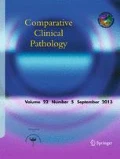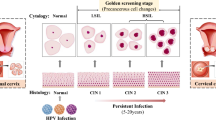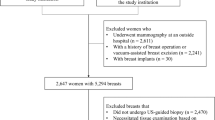Abstract
Usage machine-based learning image cytometry to establish the diagnosis of cervix cancer using cellular morphology classification in comparison to the conventional cytological test. The study was divided into two phases consisting of 15 samples of cervix cells. In phase1, with previous diagnosis, the samples were divided into three groups of five samples each: normal (NC), low-grade squamous intraepithelial lesion (LGSIL or LSIL), and high-grade squamous intraepithelial lesion (HGSIL or HSIL). Images of cells were analyzed to create a training set of cells with known diagnosis for machine learning purposes. With the numerical data created, the software was trained to automatically classify the three types of cells. In phase 2, 885 cells were classified without previous diagnosis. In a last step, the classification of CPA was compared to cytopathology. NC and HSIL were identified with a high sensitivity and specificity (99%, 99%) and (98%, 97%) respectively. While the sensitivity and specificity of LSIL cells were lower (78%, 79%). It is possible to extract features of cervical cells by automatically generating numerical data that allowed the program to identify and classify different cell classes, using simple and low-cost reagents and free, reproducible softwires.


Similar content being viewed by others
References
Agarwal N, Biancardi AM, Patten FW, Reeves AP, Seibel EJ (2014) Three-dimensional DNA image cytometry by optical projection tomographic microscopy for early cancer diagnosis. J Med Imaging 1(1):017501
Baik J, Ye Q, Zhang L, Poh C, Rosin M, MacAulay C, Guillaud M (2014) Automated classification of oral premalignant lesions using image cytometry and random forests-based algorithms. Cell Oncol (Dordr) 37(3):193–202
Böcking A, Nguyen VQ (2004) Diagnostic and prognostic use of DNA image cytometry in cervical squamous intraepithelial lesions and invasive carcinoma. Cancer 102(1):41–54
Buzin AR, Pinto FE, Nieschke K, Mittang A, Andrade TU, Endringer DC, Tarnok A, Lenz D (2015) Replacement of specific markers for apoptosis and necrosis by nuclear morphology for affordable cytometry. J Immunol Methods (Brazil) 420:24–30
Carpenter AE, Jones TR, Lamprecht MR, Clarke C, Kang IH, Friman O, Guertin DA, Chang JH, Lindquist RA, Moffat J, Golland P, Sabatini DM (2006) CellProfiler: image analysis software for identifying and quantifying cell phenotypes. Genome Biol 7(10):R100
Carvalho G (2002) Citologia do Trato Genital Feminino, 4th edn. Atheneu, São Paulo
Goda K, Di Carlo D, Jalali B (2013) Ultrafast automated image cytometry for cancer detection. Conf Proc IEEE Eng Med Biol Soc 2013:129–132
Gonçalves S, Haa P, Spada C, Fontana CS, Rangel L, Mendonça MAC, Carvalho CR (2007) Citometria de imagem do conteúdo de DNA nuclear decélulas epiteliais do colo uterino. RBAC 39(1):71–78
Grote HJ, Nguyen HV, Leick AG, Böcking A (2004) Identification of progressive cervical epithelial cell abnormalities using DNA image cytometry. Cancer 102(6):373–379
Gu SY, Yong YS, Wang YH, Du YJ (2010) The application of fluorescence in situ hybridization and automated image cytometry in the diagnosis of urothelial carcinoma of bladder. Zhonghua Wai Ke Za Zhi 48(12):933–936
Hackenhaar AA, Cesar JA, Domingues MR (2006) Examination Pap smears in women aged 20 to 59 years in Pelotas, RS: prevalence and factors associated with not performing. Rev Bras Epidemiol 9(1):103–111
Izmajłowicz B, Kornafel J, Błaszczyk J (2014) Multiple neoplasms among cervical cancer patients in the material of the lower Silesian cancer registry. Adv Clin Exp Med 23(3):433–440
Lamprecht MR, Sabatini DM, Carpenter AE (2007) CellProfiler: free, versatile software for automated biological image analysis. Biotechniques 42(1):71–75
Lee SH, Vigliotti JS, Vigliotti VS, Jones W (2014) From human papillomavirus (HPV) detection to cervical cancer prevention in clinical practice. Cancers 6(4):2072–2099
Lucena LT, Zãn DG, Crispim PTB, Ferrari JO (2011) Fatores que influenciam a realização do exame preventivo do câncer cérvico-uterino em Porto Velho, Estado de Rondônia, Brasil. Rev Pan-Amaz Saúde 2(2):45–50
Mat-Isa NA, Mashor MY, Othman NH (2008) An automated cervical pre-cancerous diagnostic system. Artif Intell Med 42(1):1–11
Meng Z, Shi J, Zhu C, Gu J, Zhou C (2013) Automated quantification of DNA aneuploidy by image cytometry as an adjunct for the cytologic diagnosis of malignant effusion. Anal Cell Pathol (Amst) 36(3–4):107–115
Mittag A, Pinto FE, Endringer DC, Tarnok A, Lenz D (2011) Cellular analysis by open-source software for affordable cytometry. Scanning 33(1):33–40
Nunes CSM, Tarnok A, Mittag A, Andrade TU, Endringer DC, Lenz D (2017) Differentiation of populations with different fluorescence intensities with a machine-learning based classifier. Comp Clin Pathol 26:385
Pinho AA, Junior IF (2003) Prevenção do câncer de colo do útero: um modelo teórico para analisar o acesso e a utilização do teste de Papanicolau. Rev Bras Saúde Matern Infant 3(1):95–112
Safaeian M, Solomon D, Castle PE (2007) Cervical cancer prevention-cervical screening: science in evolution. Obstet Gynecol Clin N Am 34(4):739–760
Satyanarayana L, Asthana S, Bhambani S, Sodhani P, Gupta S (2014) A comparative study of cervical cancer screening methods in a rural community setting of North India. Indian J Cancer 51(2):124–128
Tavares SBN, Amaral RG, Manrique EJ et al (2007) Controle da Qualidade em Citopatologia Cervical: Revisão de Literatura. Rev Bras Cancerol 53(3):355–364
Tozetti PB, Lima EM, Nascimento AM, Endringer DC, Pinto FE, Andrade TU, Mittag A, Tarnok A, Lenz D (2014) Morphometry to identify subtypes of leukocytes. Hematol Oncol Stem Cell Ther 7(2):69–75
van der Laak JA, Siebers AG, Cuijpers VM, Pahlplatz MM, de Wilde PC, Hanselaar AG (2002) Automated identification of diploid reference cells in cervical smears using image analysis. Cytometry 47(4):256–264
Watson M, Benard V, Thomas C, Brayboy A, Paisano R, Becker T (2014) Cervical cancer incidence and mortality among American Indian and Alaska native women, 1999-2009. Am J Public Health 104(Suppl 3):S415–S422
Funding
This study was funded by the Fundação de Amparo à Pesquisa do Espírito Santo (FAPES) (Leonardao Moreira Moscon).
Author information
Authors and Affiliations
Corresponding author
Ethics declarations
Conflict of interest
The authors declare that they have no conflict of interest.
Rights and permissions
About this article
Cite this article
Moscon, L.M., Macedo, N.D., Nunes, C.S.M. et al. Automated detection of anomalies in cervix cells using image analysis and machine learning. Comp Clin Pathol 28, 177–182 (2019). https://doi.org/10.1007/s00580-018-2812-4
Received:
Accepted:
Published:
Issue Date:
DOI: https://doi.org/10.1007/s00580-018-2812-4




